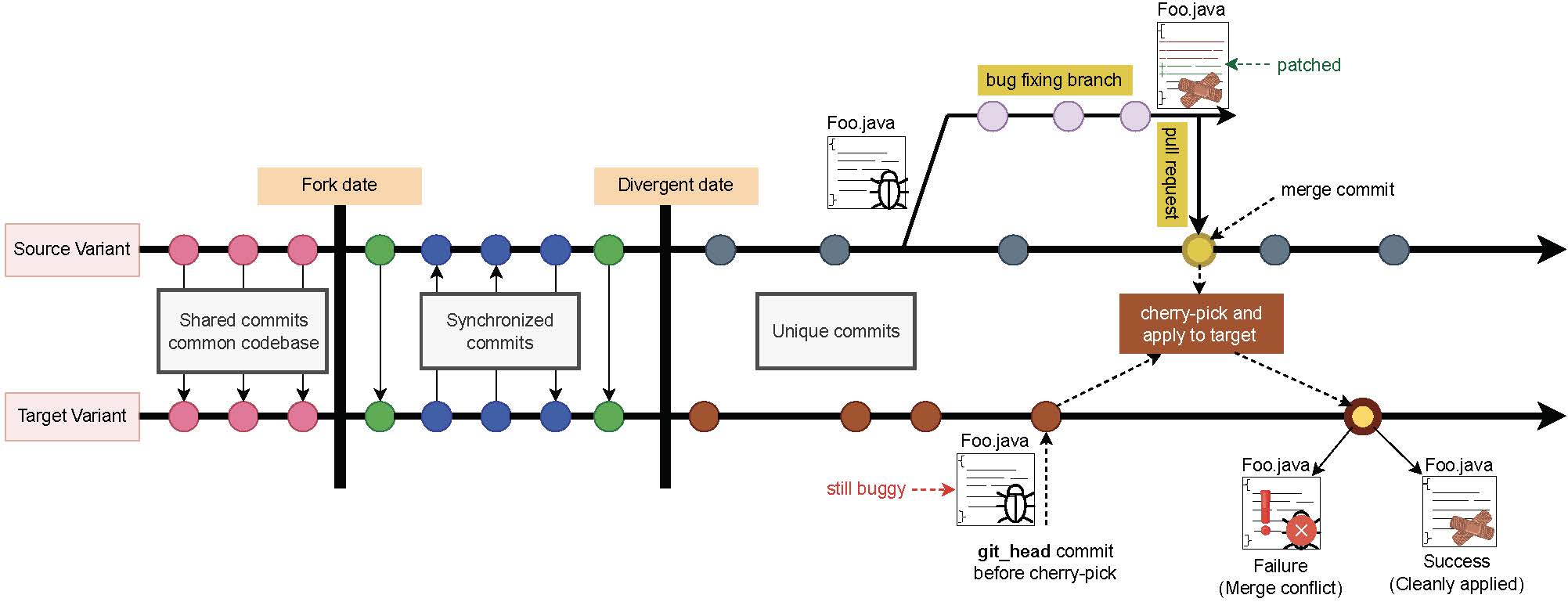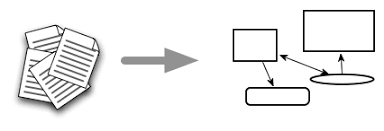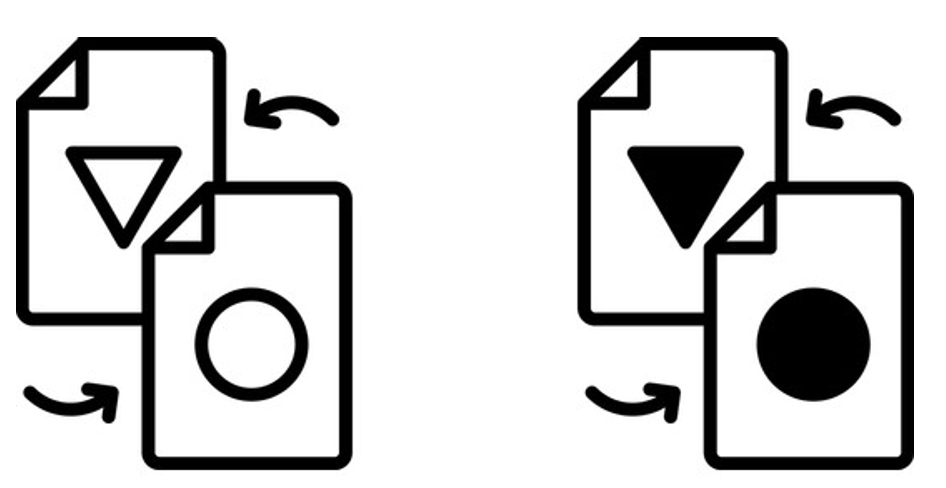Reengineering Project - linkedin/kafka
Target Application
LinkedIn project is a variant fork of Apache Kafka running at LinkedIn.
Kafka was born at LinkedIn. The run thousands of brokers to deliver trillions of messages per day. They run a slightly modified version of Apache Kafka trunk. The LinkedIn variant contains the LinkedIn Kafka release.
Assignment
1. Contextualization of the Project
LinkedIn is a clone-and-own variant of
Apache Kafka that was created by copying and adapting the existing
code of Apache Kafka that was forked on 2011-08-15T18:06:16Z. The two software systems kept on synchronizing
their new updates until 2022-06-02T17:08:43Z. Since 2022-06-02T17:08:43Z (divergence date), the two
projects do not share common commits yet actively evolve in parallel. Currently, ( as of 2025-10-01T15:01:39Z),
LinkedIn has 471 individual commits, and Apache Kafka has 7,199 individual commits. Development becomes
redundant with the continued divergence, and maintenance efforts rapidly grow. For example, if a bug is
discovered in a shared file and fixed in one variant, it is not easy to tell if it has been fixed in the
other variant.
General problem illustration
The figure below illustrates the clone-and-own development model, where Source Variant (the forked repository) was cloned and independently maintained from the Source Variant (the original repository).
When the Target Variant was forked by the developer (fork_date), it inherited all commits from the Source Variant. Between the fork_date and the divergence_date, both variants continued synchronizing commits, keeping their histories aligned. After the divergence_date, however, synchronization stopped, and the two variants began to evolve independently.
The figure below illustrates clone-and-own, where variant2 (forked repository) was
cloned-and-owned from Source Variant (original repository). When Target Variant forked by the
developer (fork_date), it inherited all commits from Source Variant. Then, between the
fork_date and divergence_date, both variants synchronized commits, keeping both
variants even. After the divergence_date, the variants stopped synchronizing commits.

Assume that after the divergence_date, a developer of the Source Variant discovers a bug in Foo.java.
To fix it, the developer creates a bugfix branch on the source repository, applies the patch to
the buggy file, and then merges the fix back into the main branch of the Source Variant via a pull request.
Later, the maintainer of the Target Variant wants to integrate this same bug fix from the Source Variant
into the git_head of the target repository. At this point, two possible scenarios can occur:
-
Successful Integration
The commit from the Source Variant applies cleanly to the Target Variant.
The patch merges without conflicts, and the fixed version ofFoo.javabecomes part of the target’s codebase. -
Failed Integration
The commit from the Source Variant fails to apply due to merge conflicts inFoo.java.
These conflicts may arise from code divergence, refactoring, or other structural differences between the two variants since the divergence_date.
Since the fork has diverged, shared file(s) in a patch (pull request) may have changed between the
Source Variant and the Target Variant. As a result, direct git cherry-pick integration often leads to merge conflicts.
Some of these conflicts are purely textual, caused by overlapping edits in the same lines of code,
while others are structural, resulting from refactoring operations independently applied in the two variants
(e.g., method renames, class moves, or interface changes between Apache Kafka and LinkedIn Kafka).
To address such cases, this project employs RePatch, a refactoring-aware integration tool capable of detecting and replaying refactorings to improve patch compatibility across diverged variants.
In this course we use RePatch, which performs refactoring-aware patch integration by aligning source and target code around detected refactorings and replaying those changes.
You have already seen how to run RePatch in the Software Integration Lab (Task 2 with PR #13386).
For the project, you are expected to:
- Reuse the same integration workflow shown in the lab, or follow the RePatch README for full instructions.
- Inspect the results in the RePatch database (
merge_result,conflicting_files, etc.) and document how conflicts were resolved, or why they could not be resolved. - Connect your observations back to reengineering patterns from the OORP book.
2. Pull Request Categories
You will work on pull requests from the following four categories.
PR Categories Spreadsheet
Each student will analyze:
- Category 1: 1 PR
- Category 2: 2 PRs
- Category 3: 1 PR
- Category 4: 3 PRs
Although each student is responsible for selecting and working on their PRs, you are expected to collaborate as a team.
- Discuss your findings, challenges, and approaches together.
- Share insights on conflicts, testing, and coverage.
- Submit one joint team report that consolidates everyone’s contributions.
- Inside the report, clearly label which PRs were handled by each student to ensure individual work is identifiable.
Category 1: Cherry-pick succeeds and includes tests
- Git cherry-pick succeeds without conflicts.
- The integrated code is already covered by tests in the target repository.
Task:
- Identify the merge commit of the patch pull request using techniques from the Mining Software Respositories class.
- Run
git cherry-pickon the identified merge commit. - Validate the integration by running the existing test suite.
Category 2: Cherry-pick succeeds but missing tests
- Git cherry-pick succeeds without conflicts.
- Some of the changed files lack test in the target repository.
Task:
- Identify the merge commit of the patch pull request.
- Run
git cherry-pickon the identified merge commit. - Write the missing unit/integration tests for the uncovered changes.
- Measure coverage before and after adding the tests to ensure improvement.
Category 3: Cherry-pick fails, RePatch succeeds
- Git
cherry-pickfails due to structural divergence. - RePatch successfully resolves conflicts and integrates the PR.
- Some files may or may not have test coverage.
Task:
- Run RePatch and inspect the generated integration results to ensure correctness.
- Validate the integration by running the existing test suite.
- If tests are missing, write unit/integration tests for the uncovered changes.
- Measure coverage before and after adding tests to confirm improvement.
Category 4: Cherry-pick fails, RePatch cannot resolve conflicts
- Both Git
cherry-pickandRePatchfail due to unsupported refactorings or complex semantic/textual conflicts.
Task:
- Identify and document the specific reason for failure (e.g., unsupported refactoring, semantic conflict, or other complex change).
- Attempt small, e (e.g., updating a method signature, adding a missing parameter).
- If integration remains infeasible, clearly explain why developer intervention and domain knowledge are required.
- Reflect on the nature of these conflicts and discuss potential directions for extending or improving RePatch to handle them.
3. Getting Started Instructions
Please pay attention to the following instructions:
- Each group must prepare a Pre-conditions Report (PDF format).
- Only one member per group should submit the report on Canvas on behalf of the group.
- The report must include:
- The full names of all group members (maximum of 3 people per group; groups of 1–2 are also allowed).
- Your Pre-conditions Report should contain the following:
- Project Name
- Full names of all the members in your group
- A link to your GitHub repositories (which shows you already forked LinkedIn
- The members are set as collaborators to the GitHub project.
- Invite me as collaborator on your forked repositories. (my GitHub ID -
johnxu21).
- Demonstrate the ability to build the projects. For this, we want a statement from the group attesting they managed to successfully build the projects. You can also attach a screenshot of your IDE with the project source and a message like “build successful”.
- Simple Class Diagram of one of the pull requests being patched (or buggy target). A simple class diagram has only the name of the class and its interactions with the other classes (there are two examples in JPacman repository in the “docs” folder). This is to reinforce your initial understanding of the system. You only need to focus on the classes associated with the patch and the classes that are called in those classes. There is no need to go deeper into the class structure (i.e., if buggy class calls Class X, and Class X calls Class Y, then you do not need to show Class Y since it is not being called directly by the buggy class). We are not going to evaluate your strictness to the proper UML notations, therefore focus on modeling and understanding classes interactions.
Pre-conditions Report
Each group must submit a Pre-conditions Report (PDF). Only one member should upload it on Canvas on behalf of the team.
The report should include:
1. Group & Repository Setup
- Project name
- Full names of all group members
- Link to your forked LinkedIn Kafka repository
- Confirmation that all group members are added as collaborators
- Add me as a collaborator on your fork (
GitHub ID: [johnxu21](https://github.com/johnxu21))
2. Build Confirmation
- A short statement confirming that your group was able to successfully build the project
- Each group member must include a screenshot from their own IDE showing the project source and a “Build Successful” (or equivalent) message
- All screenshots should be compiled into the same PDF report
3. Initial System Understanding
- Provide a simple class diagram for one of the pull requests you will work on (or the buggy target)
- Focus only on:
- The class(es) affected by the patch
- The classes directly called by those classes
- Do not include transitive dependencies (e.g., if Class A calls Class B, but Class B calls Class C, you don’t need to include Class C)
- Strict UML notation is not required — clarity of interactions is the priority
- See examples in the JPacman repository (“docs” folder)
4. Team Coordination (Optional)
You may include a short plan for how your team will coordinate during the project.
This is not graded, but it will help your group stay organized.
Consider including:
- Meeting Schedule: How often will you meet (weekly, bi-weekly)? Online or in person?
- Communication Tools: Which tools will you use (Discord, Slack, email, GitHub issues)?
- Collaboration Practices: How will you share progress on your assigned PRs (e.g., regular updates, peer reviews, or joint testing sessions)?
- Contingency Plan: How will you handle missed deadlines, unresolved conflicts, or a teammate being unavailable?
4. General Coding Instructions
When working on this assignment, follow these repository and coding practices:
- Fork and Clone
- Fork LinkedIn Kafka and clone the source code for your team to work on.
- Refer to the project’s documentation for build instructions, but adapt as needed since open-source projects may have outdated documentation.
- Collaboration
- Add all members as collaborators on the fork.
- Ensure that everyone has access to build, test, and push changes.
- Commit and Push Practices
- Commit and push regularly with clear, descriptive messages.
- Each commit should represent a single coherent activity (e.g., resolving a conflict, adding tests, applying a patch).
- Avoid large commits that combine unrelated changes.
- Commit Message Guidelines
- Write concise messages that explain the purpose of the change.
- Examples:
fixing merge conflicts on patch X, class Yadding unit tests for class Yrefactoring class Y to apply patch + added new test
- If possible, separate code changes and tests into different commits (this improves traceability).
- Commit History and Evaluation
- Your GitHub commit history will be reviewed as part of the evaluation.
- A consistent, clear, and incremental history is expected.
- Make sure to commit and push the final version of your reengineering project before the deadline.
5. Development Activities
For each assigned pull request (according to the four categories), perform the following activities and document them in your project report.
I. Design Recovery

- Extract and describe the local design of the classes and methods affected by the pull request in the source variant using IntelliJ or a similar tool.
- Identify the corresponding classes or components in the target variant where the integration will occur.
- Compare both contexts to highlight structural or architectural differences (e.g., renamed classes, relocated methods, split responsibilities).
- A simple side-by-side diagram or annotated class sketch is sufficient; focus on showing the design gap between the two variants.
- For Category 4 PRs: focus on analyzing the existing design of the target variant and identifying the architectural misalignments or refactoring-induced differences that prevent successful integration. Since the patch cannot be integrated, no redesign is expected, only a discussion of the design barriers encountered.
II. Design Adaptation / Redesign

- Analyze how the integrated change (patch) modifies or extends the existing design.
- Compose a revised design view that shows how the functionality now fits into the system and interacts with related components.
- If you wrote new tests, explain how the design of the test suite evolved to handle the change.
- Confirm that the redesign supports the new feature/bug fix without degrading code quality.
- Exclude Category 4 PRs: since these fail to integrate, instead describe the design barriers that caused the failure (e.g., incompatible refactorings, missing interface, or semantic mismatch).
III. Integration and Testing
- Attempt to integrate the PR using
git cherry-pick. - If cherry-pick fails, run RePatch and document the results.
- Validate the integration by running the test suite of the target variant.
- If tests are missing, write appropriate unit/integration tests.
- Report coverage before and after integration and reflect on the adequacy of the test suite.
IV. Project management

- Estimate the effort required for:
- (i) integrating the patch, and
- (ii) creating/adapting tests.
- Identify PRs that were exceptional entities (e.g., large number of files changed, complex conflicts).
- Comment on risks to maintainability and potential long-term design debt introduced by the integration.
V. Refactoring and Manual Resolution

- If RePatch cannot resolve conflicts, attempt manual resolution (e.g., adjusting parameters, handling renamed methods).
- Document any refactorings you performed to make the integration feasible.
- If manual resolution is not possible without developer intent, explain why.
- Ensure tests remain effective and coverage is preserved after changes.
VI. Reflection on Patterns, Techniques, and Teamwork
- Identify the reengineering patterns from the OORP book that informed your design, integration, testing, and refactoring decisions.
- Reflect on how your team coordinated across categories (meetings, reviews, shared testing).
- Summarize lessons learned about design, variant-aware integration, and testing.
In addition, your report should demonstrate the use of techniques introduced in the lab sessions:
- Analyzing: Metrics & Visualization; Mining Software Repositories.
- Restructuring: Testing, Refactoring, and Integration.
You are not required to use every technique, but you must justify your choices:
- Explain why you applied certain techniques and why others were not relevant to your case.
- Discuss the benefits and drawbacks of the chosen approaches.
- You may also use alternative techniques or tools if they are better suited, but explain why.
Testing requirements:
- Determine how well the existing tests provide feedback for your refactoring and integration steps.
- Quantify adequacy (e.g., show coverage before and after).
- Argue whether the tests are sufficient for your chosen scenario.
- If they are inadequate, adjust or extend them efficiently—balance thoroughness with time investment.
6. General Evaluation
To successfully complete the project, your report and implementation must demonstrate:
- Use of Reengineering Patterns
- You can plan and select appropriate patterns from the OORP book to guide your activities.
- Your report explains which patterns were applied and why.
- Application of Analysis Techniques
- You have applied one or more techniques from the lab sessions (e.g., code integration, mining software repositories, metrics & visualization, testing).
- Alternative techniques/tools are welcome, but you must justify their relevance.
- Evidence must be provided (e.g., screenshots, outputs, coverage reports, or metrics) along with your interpretation of the results.
- Execution of Project Activities
- You have carried out the activities for each PR category (integration, testing, design recovery, redesign, refactoring/manual fixes).
- Your report explains the steps taken and the reasoning behind your decisions.
- Behavior-Preserving Restructuring
- Refactorings and integrations do not break functionality.
- Demonstrate correctness by showing:
- The mapping between classes before and after changes.
- Successful compilation.
- Test results that pass consistently.
- Increased or maintained test coverage to support reliability.
- Design Justification
- Your revised design clearly shows how the integrated patches fit into the system architecture.
- The design should improve or at least maintain code quality and system clarity.
- You are not required to perform every possible refactoring; instead, execute a representative set that illustrates your proposed solution.
- Quality of the Report
- The report is clear, well-structured, and documents all steps of your work.
- Reasoning, evidence, and reflections must be included—not just raw results.
- Remember: the report is the primary artifact used for evaluation.
For a detailed breakdown, consult the evaluation checklist available on the course main page.
7. Report
This project is a software reengineering process applied to variant-aware patch integration.
Your report should demonstrate how you applied reengineering concepts — analysis, design recovery, restructuring, and validation — in the context of the four PR categories.
The following aspects must be addressed:
- Context
- Briefly describe the context of your project: reengineering through patch integration across diverged variants (Apache Kafka → LinkedIn Kafka).
- Frame this as a reengineering challenge, not just a code merge.
- Problem at Hand
- Clarify the reengineering problems encountered in PR integration (e.g., divergence, refactoring conflicts, missing tests).
- Discuss their intrinsic difficulties.
- Reengineering Patterns
- Explicitly state the OORP patterns you selected and used.
- Explain how these patterns informed your analysis, design, integration, testing, and refactoring.
- Teamwork and Coordination
- Describe how your team coordinated work across the four categories.
- Explain how responsibilities were managed, reviews conducted, and challenges addressed.
- Reflect on the effectiveness of your coordination strategy.
- Reengineering Patterns
- You must show how OORP patterns guided your work.
- Do not list patterns in isolation; instead, introduce them in the context where they were applied:
- In Design Recovery/Adaptation: Which patterns helped you understand or adapt the architecture?
- In Integration: Which patterns helped you resolve conflicts or prioritize patches?
- In Testing: Which patterns informed how you verified correctness or extended the test suite?
- In Refactoring: Which patterns guided structural changes while preserving behavior?
- In your reflection section, briefly summarize which patterns were most useful across the categories and why.
- Reflection on Techniques
- Discuss which analysis techniques from the labs (e.g., metrics, mining, visualization, integration tools, testing) were applied.
- Justify your choices and evaluate their benefits/drawbacks.
- Consider alternative techniques/tools where relevant.
- Conclusion
- Summarize lessons learned about software reengineering in the context of PR integration.
- Highlight insights about design, testing, refactoring, and teamwork that extend beyond this specific case.
Note: The Intermediate Report may cover partial progress with less detail. The Final Report should provide a full, polished account of your reengineering process. The Pre-conditions Report only ensures setup, but early planning on patterns and risks will strengthen your final outcome.
Please also review the Report Guidelines and Evaluation Checklist on the course’s main page.
8. Final Remarks
If you have any questions about the project or the report, please contact me.